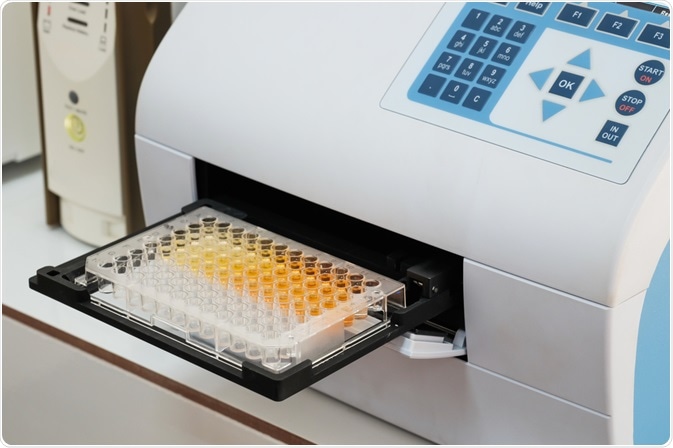Micro-plates or ‘micro-titers’ are shaped plates consisting of a number of small test tubes, or wells, which facilitate analytical research and diagnostic testing in the medical sciences. The presence of an array of tubes, in a small and handy palette, makes the titration process faster and more effective.
 Image Credits: Khamkhlai Thanet / Shutterstock.com
Image Credits: Khamkhlai Thanet / Shutterstock.com
Since time is of the essence in studying biochemical reactions, the increase in the effectiveness of titration reactions can largely be attributed to a decrease in the operation time of the titration procedures. This decrease has been largely facilitated due to the introduction of micro-plates, which help in administering multiple reactants within a short period of time.
The number of wells can vary on a micro-plate from 6 to 1536, and depending on the requirement, the wells may be covered with a heat-sealed foil or thin film. At other times, it is the adhesion and cohesion properties of the solvents that govern the type of well material to be used.
Thus, the manufacturing process and the raw material used in the process are a function of the applications, requirements, and properties of the solvents used in the well tubes.
Components and material of micro-plates
The most common micro-plates are made out of polystyrene, polypropylene, and cyclo-olefins. The first type is used for optical detection plates. These plates are capable of handling large temperature variations, and they respond well to thermal cycling.
Their non-reactivity also helps in ensuring long term storage for most solutions. Addition of titanium dioxide to polystyrene results in a white-colored plate, which can be used for absorbance and luminance detection. Similarly, the addition of carbon to polystyrene leads to a black colored plate, which can be used for fluorescent assays.
During the 1980s, it was observed that though micro-plates had reduced human effort in titration, the cost of operating them was still high. Scientists developed polycarbonate-based plates, which were batch-produced at cheap rates, and could be disposed of once used. They were most prominently used during polymerase chain reactions of DNA Amplification. Similarly, cyclo-olefin based titers were used to transmit UV light.
The level of adhesion and support provided by the cells is decided based on the reaction to be carried out, with high cell attachment processes generally requiring positively charged surfaces. Similarly, the mechanical stability and contamination control requirements decide what material is to be used in cells.
Manufacturing process
The first step in manufacturing the micro-plate is designing the plate. Nowadays, the software provides scientists and manufacturers the freedom to choose the well shape, size, number, pattern, texture, and material, so that custom plates can be manufactured.
The most common practice used for manufacturing micro-plates is injection molding, where molten metal is inserted into molds in order to create precision machined micro-plates. Since the sizes involved require very high accuracy, it is generally computer-controlled injection and removal from the molds that happens.
The process involves the manufacturing of multiple micro-components, and micro-plates such as composites, filter bottom plates, and advanced PCR designs involve intricate machining and fitting to generate the final plate.
Another common manufacturing process is the use of glass to make the plates, with vacuum forming done to generate the well patterns. Commercially, the usage of this method is limited to polycarbonate based plates, and mass production is generally done through injection molding the inserts.
The next step after injection molding or vacuum forming is surface treatment and specialist assembly. Depending on the shape of the well required, there are ‘F bottoms’, ‘C bottoms’, ‘V bottoms’ and ‘U bottoms’. The shapes and profiles are precision molded using computer-controlled injection machines.
The level of adhesion is also pre-decided in the wells and accordingly, there are high surface-binding and low-binding types of cells. The number of cells to be made is a function of the speed needed for processing and the ability of the plate to ‘hold’ multiple titrations simultaneously, in close proximity.
The gap in between cells and the sealing required is also decided based on the reactivity of the titration solutions and their stability when co-existing in a small space.
Once a well pattern has been created on the surface, the surface is machined to remove any aberrations and is checked for defects. Sub-assemblies are joined together, the type of binding is decided, and the final micro-plate is shipped out for testing.
Once the plates have been made, the next step is readying the handling equipment and storage facilities, such as robotic washers, automation accessories, readers, and instrumentation. Depending on the material and properties of the wells, the supporting equipment is also designed and manufactured.
Conclusion
The choice of materials, manufacturing and finishing processes pivots around the choice of well properties and characteristics. Depending on the qualities needed in the wells, namely adhesion, temperature sensitivity, assay types, optical and plasma responsiveness, the selection of the micro-plate’s components and manufacturing processes is done.
Sources
Corning, Microplates selection guide, DOI: https://www.corning.com/media/worldwide/cls/documents/CLS-C-DL-MP-014REV9.pdf
Porvair, Custom manufacturing, Porvair sciences, DOI: https://www.microplates.com/custom-manufacturing/
Well plate, Select the right well plate material for highest quality for reproducible results from test to test!, DOI: https://www.wellplate.com/well-plate-material/